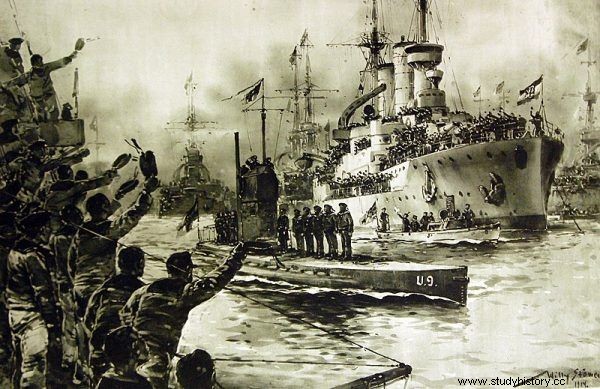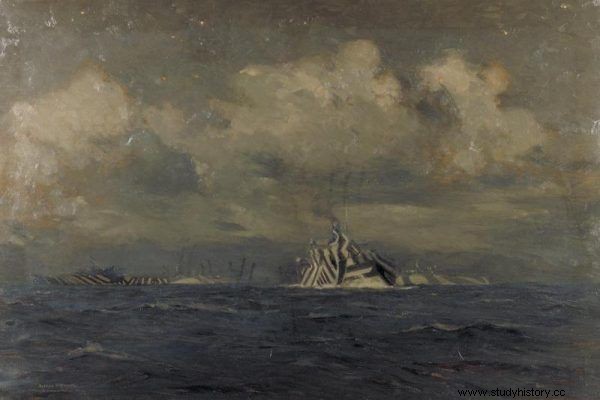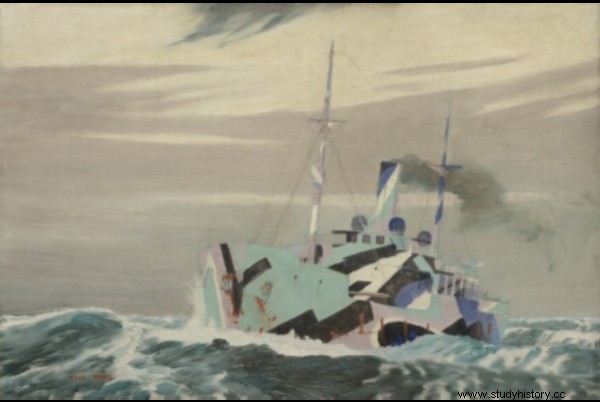How to hide a ship on the high seas? Is it possible at all? Such questions were asked by the command of the British Navy during the First World War.
A great ship will not become invisible, even if we paint it in the color of the sky or the sea, after all, depending on the weather conditions, the sky and the sea may have a different color. Perhaps, however, it is possible to make the ship look different than it really is and could cause the enemy to be confused? The answer to this question is yes. Another question arises - how to do it?
Attacking U-Boats
The German navy during World War I was not well developed. At least not as good as British. This empire had modern ships, well-trained crews and, additionally, several hundred years of experience in managing such a large fleet. Therefore, the Germans had to use their wits.
British merchant ships sailing around the world kept the country in great economic condition. Our western neighbors attacked the sluggish and slow merchant ships with fast and maneuverable submarines:U-Boats.

The triumphant return of the U-9 to Wilhelmshaven after a voyage that ended with the sinking of three cruisers. Drawing by prof. Willie Stöwer.
The scale of successful attacks was huge. At the turn of March and December 1917, the Germans sank almost three British ships a day. In this situation, the command of Great Britain and the USA (which, after the so-called Zimmermann message and as a result of Germany's unlimited submarine war, entered the war) began to wonder how to make the ship disappear .
Artificial islands with palm trees
The inventor we all know - Thomas Edison - proposed to paint and deck the ships so that they looked like islands (masts were to be stylized as palm trees) . Apparently, even one of such ships was built, but it was not suitable for active service, as the slight wind was destroying the decorations.
There were a dozen ideas: an attempt to paint the ship to look like a whale, or the use of large mirrors to make the ship disappear from sight . The brainstorm was in full swing, and the perfect solution was proposed by Norman Wilkinson - a marine painter and artist. It was natural to Norman that it was impossible to make the ship disappear. His idea was based on an attempt to confuse the enemy, who could look at the ship through, for example, a periscope telescope. He said: "We can't hide the ship, so at least let's try to hide its intentions."
The implementation of the idea has begun. Wilkinson was given access to a great painting studio, as well as a staff of people. Ship models and ship plans were prepared, each project had to be different so that the Germans could not learn the patterns by heart.

Dazzle camouflage in the painting by Norman Wilkinson
Dazzle camouflage
The stunning camouflage was based on the use of a multitude of colors and shapes. The German U-Boats were equipped with a dozen or so non-steerable torpedoes, which was crucial for the use of such a painting of ships. The U-Boat crew had to calculate exactly where the enemy ship would be in several minutes to be able to launch the torpedo. It had to be done quite quickly, because in order to determine the position of the attacked ship, the U-Boat emerged just enough that the periscope telescope protruded above the surface (the detection of the submarine made the mission impossible, usually leading to her sinking).
The U-Boat crews, having a limited time to make a decision, paid attention mainly to the ship's funnels (they provided information about the ship's direction) and to the size of the bow wave, which indicated how fast the enemy ship was moving. With these basic data, the Germans were able to calculate where the torpedo would eventually be launched.
Wilkinson decided to paint the chimneys with dark stripes to indicate the opposite movement of the ship and to paint the sides with enlarged arcs making it much more difficult to read the speed. To further confuse the enemy, Norman introduced large, lattice patterns to create an illusion; the observer saw the stern where the bow and vice versa.
In May 1917, the first ship painted in this way - HMS "Industry", set sail. Ships off the coast were ordered to observe the ship in question and record its speed and direction. Most of the observers reported data other than true speed and direction. This made Wilkinson receive another batch of paintable ships. By the end of the war, he managed to repaint almost 4,500 ships.

Norman Wilkinson repainted almost 4,500 ships by the end of the war
Did it actually work?
After the war, it was decided to carry out a dozen or so tests. A special team was set up to carefully examine whether the camouflage is fully effective and whether it affects the ship's safety. Many captains and officers have complained that their beautiful and formidable ships look like ... decorations on Christmas trees .
The test results indicated that the painted ships were not as safe as assumed. However, the British Navy said it was a good idea. Why? Crews on "camouflaged" ships had higher morale than their colleagues from traditionally painted ships . In addition, the insurers were levying lower rates on ships with Wilkinson designs.
Painting the ships in stunning patterns has ended with the advancement of technology. Radars and better instruments for measuring distances from enemy ships began to be used. Such painting was repeated during World War II, but not on such a scale. The patterns proposed by Wilkinson were eagerly used by designers on clothes, devices and even cars, although the "nightmarish patterns of a drunken painter" had more opponents than supporters.
Bibliography:
- Behrens R., False Colors; Art., Design and Modern Camouflage, Iowa 2002.
- Forbes P., Dazzled and Deceived:Mimicry and Camouflage, Yale University Press 2009.
- Hartcup G., Camouflage:A History of Concealment and Deception in Wari, New York 1980.
- Williams D., Naval camouflage, 1914-1945:a complete visual reference, Naval Institute Press 2001.
